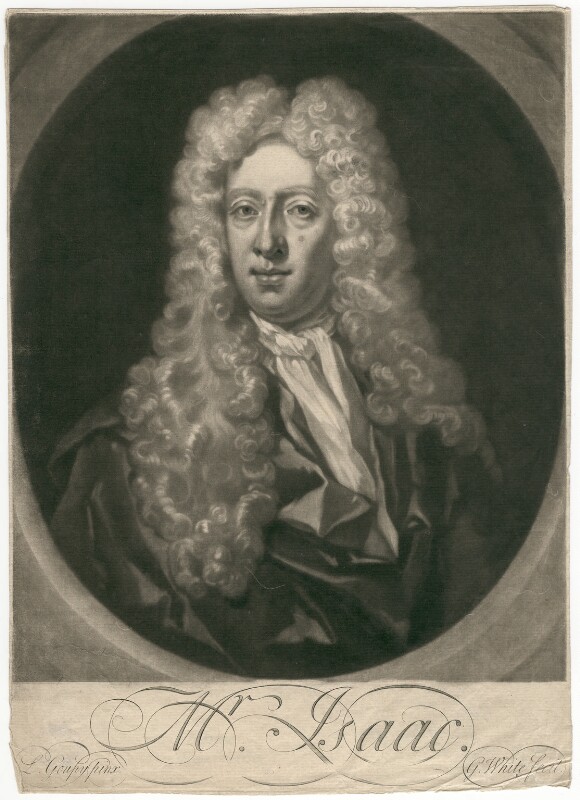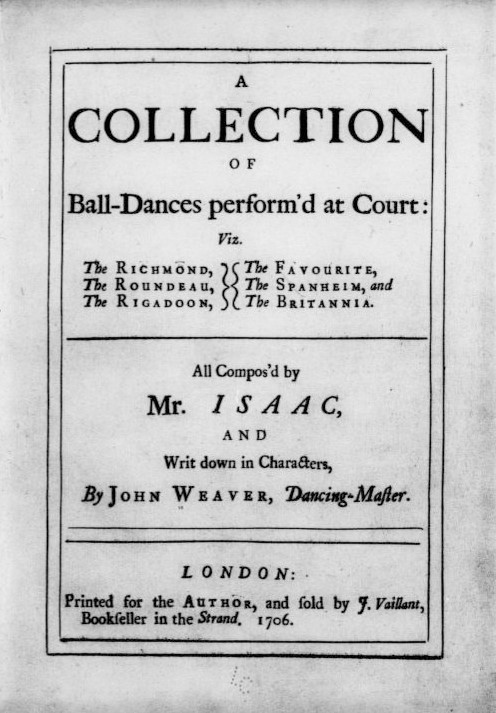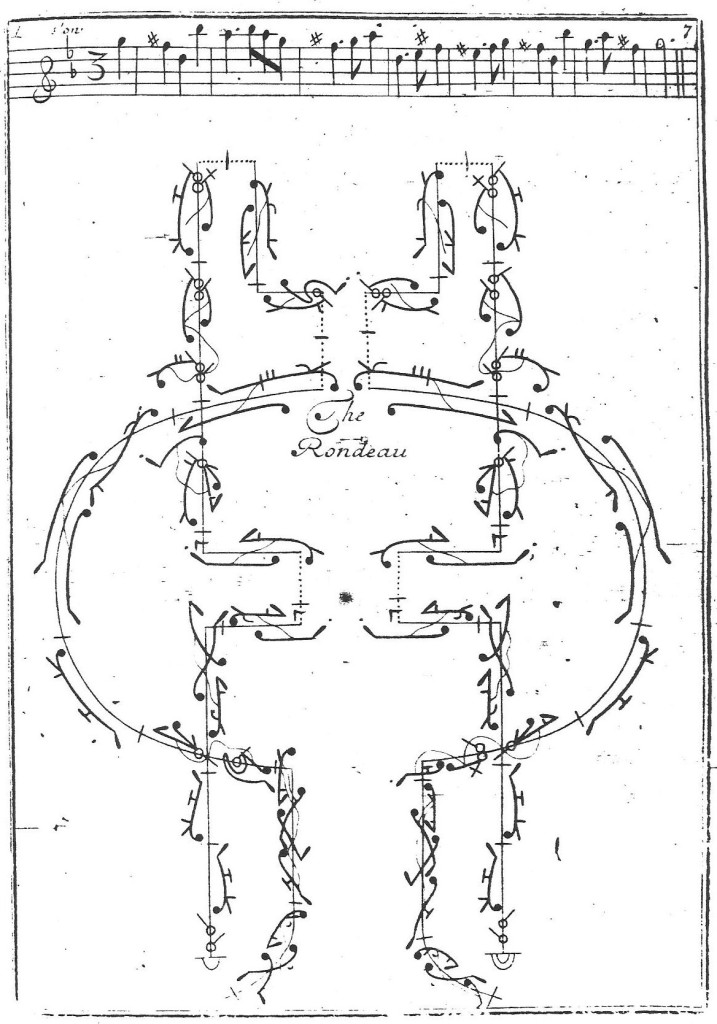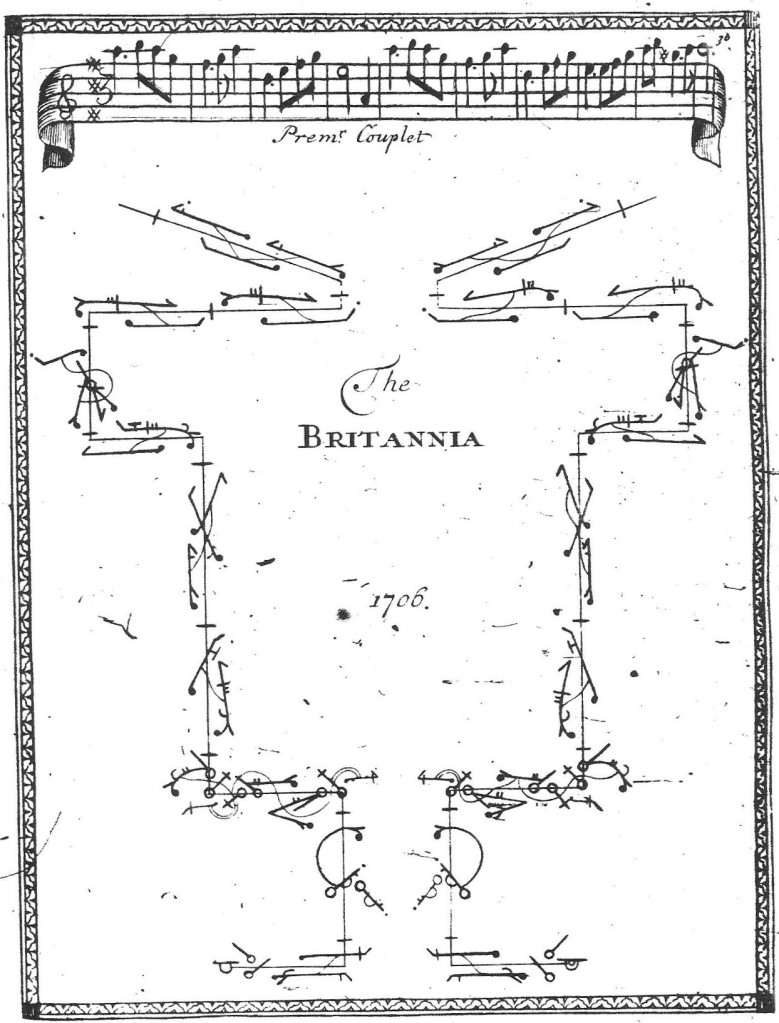A Collection of Ball-Dances perform’d at Court; … All Compos’d by Mr. Isaac and Writ Down in Characters, by John Weaver was published in London in 1706. There is evidence to suggest that at least one individual dance had already appeared, but it was certainly the earliest collection of dances to be published in London in Beauchamp-Feuillet notation. It was intended to accompany Orchesography, Weaver’s translation of Feuillet’s Choregraphie, which appeared the same year. This is made clear by the advertisement in the Daily Courant for 25 June 1706, which calls it the ‘Second Part’ of Orchesography.
It was also the first collection of English choreographies and close analysis suggests that these had a character quite distinct from the French ball dances being published in notation in Paris around the same time. We have no portrait of Weaver, but there is this print of Mr Isaac, engraved by George White after a portrait by Louis Goupy which seems not to survive.
The Collection of Ball-Dances was ‘printed for the Author’, presumably Weaver who had produced the notations and who had signed the work’s dedication to the Duke of Richmond. It was published by subscription – 47 names appear in the List of Subscribers, all of whom were men and most (if not all) were dancing masters. Both Isaac and his brother-in-law Anthony L’Abbé subscribed and the list is otherwise almost identical to that for Orchesography (see my recent post Subscription Lists and London’s Dancing Masters: John Weaver for more information).
So far as we know, the Collection survives in only two copies now in the USA, at the Library of Congress and Harvard University Library respectively. There is a possible third copy at the British Library, bound with other notated dances, which I hope to be able to discuss in a separate post in due course.
The order of the dances on the title page reflects their order in the volume.
This order is confirmed by pagination in the top right-hand corner of each plate, although three of the dances – The Rondeau, The Favourite and The Spanheim – have additional individual paginations in the top left-hand corner of each of their pages. The Britannia is engraved in a different style from the rest of the choreographies, not only does it have a decorative border on its first plate but the notated steps have different profiles. These details raise questions about the compilation of the collection, which may have been brought together after some of the dances had been notated for separate publication. I hope to be able to discuss some of these possibilities when I look at the individual dances in later posts.
The dedicatee of A Collection of Ball-Dances perform’d at Court was Charles Lennox, 1st Duke of Richmond (1672-1723), the son of Charles II and his mistress Louise de Kérouaille, Duchess of Portsmouth. In his dedication to the Duke, John Weaver writes ‘from your Grace it was that I receiv’d the first encouragement in the Subscription towards this Undertaking, and all, or most of the following Dances, have been Honour’d with your Grace’s Performance’. This portrait by Sir Godfrey Kneller depicts the duke around the time the Collection was published.
Weaver suggests that Richmond had provided some financial support for the publication of the Collection, although his name does not appear in the list of subscribers. Was there another unpublished list of the royal and aristocratic contributors to the costs of publication?
There is also the question of which dances the duke had in fact performed. Weaver’s uncertainty (he writes ‘all, or most’) is perplexing. We know that Isaac was the creator of all six choreographies and he would surely have been able to provide Weaver with accurate information about their performers (Isaac and Weaver were close collaborators over some years). So, did the duke perform only some of the choreographies when they were first given at court, perhaps dancing others at private gatherings to which Isaac was not privy? Whichever ones he did dance, who did he partner?
According to evidence presented by the American dance historian Carol Marsh, in her 1985 thesis ‘French Court Dance in England’, the six dances in this collection may range in date of composition from 1690 to 1706. She draws on the publication date of the music for each dance to indicate when the corresponding choreographies might have been created (the resulting chronology does not relate to the order of the dances in the volume). Isaac’s ball dances thus belong to the court culture of William III and Mary II as well as the early years of Queen Anne. There was more dancing at court in the 1690s than many historians realise, which might also have implications for our understanding of dancing on the London stage during that decade.
Isaac’s six dances have other features which are important for our understanding of ballroom dancing of the period. Here is a summary of basic information about each of the notated choreographies, in the order in which they appear in the Collection, together with an image of the first plate of notation.
The Richmond: 1695 or before. The music was published in The Self-Instructor (London, 1695). The dance is a hornpipe in 3/2, with the musical structure AABBCCDDEEFF’ (A=B=C=D=E=4 F= 8, F’=4 as a petit reprise), and has 52 bars of music.
The Rondeau: c1693. The music was published that year in the 7th edition of Apollo’s Banquet. The dance uses music in a slow 3 and duple time, with a concluding minuet. As the title suggests, the musical structure of the first part is AABACAA (A=B=C=8. A is the slow 3, B and C are in duple time). The musical structure of the minuet is also AABACAA (A=B=C=8, written in 3, i.e. 3/4 rather than 6/4). There are 112 bars of music in all.
The Rigadoon: c1695-1698. An alternative version of the music for Isaac’s choreography was published in Theatre Musick I in 1698 (there is no concordance for Weaver’s version). The dance is a rigaudon and was acknowledged as Isaac’s most famous choreography. The musical structure is AABB (A=4 B=6), played four times to provide 80 bars of music for the dance.
The Favorite: c1690 or earlier. The music was published in the 6th edition of Apollo’s Banquet in 1690, although it can also be found in the Deusiesme recueil des dances et contre-dances (Amsterdam, 1688). It is a chaconne followed by a bourrée. The chaconne has three variations (4+4 bars, 4+4 bars, 8+8 bars) and is played through twice. The bourrée is AABBB’ (A=B=8, B’=4 and is a petit reprise). In all the dance has 100 bars of music.
The Spanheim: may date between 1701 and 1705. The music was published in the Second Book of the Lady’s Banquet in 1706 and there was a country dance to the tune published in 1705. This dance is a gigue, with the musical structure AABBCCDD (A=4 B=6 C=4 D=6), which is repeated to give 80 bars of music.
The Britannia: this was the dance created for Queen Anne’s birthday on 6 February 1706. Although the music was published in 1706 by John Walsh and Joseph Hare together with other ‘new Minuets, Rigadoons, and French Dances, danced at Balls and publick Entertainments’, no copy of this is known to survive. This is another multi-partite choreography, beginning with a section in triple time, followed by a bourrée and then a minuet. The triple-time opening section has the musical structure AA (A=10). The bourrée is also AA (A=14), while the minuet has a rondeau structure AABACAA (A=B=C=8). The whole dance has 104 bars of music.
The music for The Britannia, along with that of many of the dances published after 1706, has been attributed to James Paisible, who may also have provided music for some of the earlier choreographies.
Over the years, I have performed The Richmond and The Favorite and I have worked on The Rondeau and The Rigadoon. I have never danced either The Spanheim or The Britannia, although I am looking forward to learning both of them in due course (albeit on my own, which makes analysis of these duets tricky).
There are another fifteen notated duets by Mr. Isaac, some of which can also be dated to the period between 1690 and 1706, although all were ostensibly first published after 1706. These begin with The Union of 1707 (another choreography I have danced) and end with The Morris of 1716 (a dance I hope to work on at a later date).
All of Isaac’s dances are challenging and even perplexing – as the above short descriptions of the six choreographies in the 1706 Collection suggest. They are very different in style (and even in technique) to the contemporary duets created by Guillaume-Louis Pecour. Were they the product of Isaac’s personal approach to choreography, or do they reflect the idiosyncrasies of English court dance in the French style? Isaac was part French and may well have trained in Paris (he certainly danced in some of the ballets given at the court of Louis XIV), which adds to the questions surrounding his dances. I will try to discuss each of these six dances in separate posts as and when I have done sufficient work on them. I have written on Isaac and some of his dances before and I give a list of these earlier posts below, for those who might be interested.
Earlier Posts
Isaac’s Rigadoon
Isaac’s Rigadoon: the Choreography
Reconstructing Isaac’s Rigadoon
Mr Isaac’s ‘The Favorite A Chaconne Danc’d by Her Majesty’
Further Reading
Carol Marsh, ‘French Court Dance in England, 1706-1740: a Study of the Sources’ (unpublished PhD thesis, City University of New York, 1985)
Meredith Ellis Little and Carol G. Marsh, La Danse Noble: An Inventory of Dances and Sources (Williamstown, 1992)
Jennifer Thorp, ‘Mr. Isaac, Dancing Master’, Dance Research, 24.2 (Winter, 2006), 117-137
Moira Goff ‘The testament and last will of Jerome Francis Gahory’, Early Music, 38.4 (November 2010), 537-542










